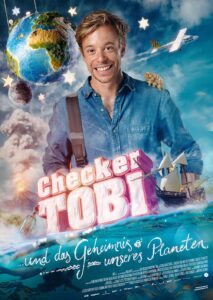A documentary which mixes in a nice message along with loads of fun and adventure, “Checker Tobi und das Geheimeis unseres Planeten” (“Checker Tobi: and Our Planet’s Secret,” English title) is great for the whole family to watch and learn from. It’s not exactly a National Geographic documentary with an Attenborough-esque voiceover either, but often feels more like a highly informative travelogue.
It begins with our eccentric protagonist Checker Tobi, who is filming a pirate adventure movie aboard a ship when he finds a magical message in a bottle floating about in the sea. A voice emerging from this plain piece of parchment ‘informs’ Tobi to meet the brave and passionate volcanologist Ulla first, and together they then embark on a journey to a lava bomb spitting volcano.
Along the way he is guided by both his human guides (like Ulla, Devaki, and Uli), as well as the cryptic talking parchment which urges him to push the envelope further. This leads to meeting more people such as Uli the biologist with whom he tracks down 8-legged bears in Tasmania (strangely not bears as the name suggests, but organisms from seemingly another dimension), and he ends up finding creatures which sound mystical, but are in fact very real. He takes in all the diverse flora and fauna, i.e. all the precious treasures that Mother Nature has to offer. However, in Greenland, he uncovers a scary reality known as climate change.

The cinematography in “Checker Tobi” is stunning, and viewers are treated to both the scariness as well as the beauty of Nature—from the exploding embers of the lava bombs as Checker Tobi and Ulla stand dangerously close to the crater of the volcano and stare into the ‘heart of the Earth,’ to an underwater Tasmanian paradise as Checker and Uli go diving. It is also a visual delight, and I loved the use of mostly blues and yellows for the colour palette which exudes and lends an earthy and fresh feel to proceedings. One is immersed and at once engaged in all that is happening on-screen—from our protagonist and his companions catching a glimpse of their first dolphin in Tasmania or humpback whale while in Greenland, to Checker getting drenched in the monsoons of Mumbai where water can be a scarcity.
The documentary also boasts kid-friendly graphics in order to hold the attention of even younger viewers, and thus can be watched by the younger and older generation…and hopefully future generations too. It also taught me a lot about the natural resources in my own country, and will definitely make everyone, regardless of what country/continent they live on, to not take their natural resources for granted as well.